Cost of Living in Serbia
December 15, 2024
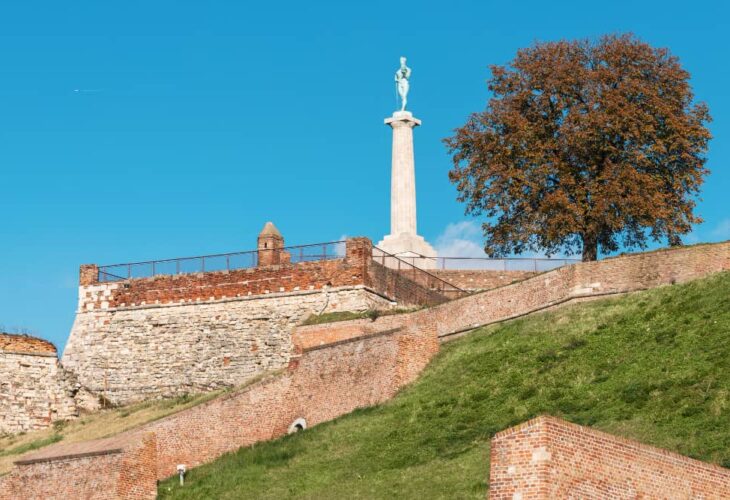
Serbia is rich in many hidden gems, as well as significant historical monuments and structures. Given our country’s vast cultural and historical heritage, it’s not surprising that remnants of ancient buildings are preserved throughout the land. Certain fortresses have successfully withstood both time and upheavals, while others are less preserved, resembling more like ruins, fragments of a distant past behind us. Nevertheless, one thing is certain: Serbia’s fortresses are important and indispensable testimonies to our state’s significant and often turbulent past.
Kalemegdan Fortress represents a unique cultural monument, surrounding one of the most beautiful parks and green areas in Belgrade. This fortress has always been a place of many legends, events, and stories, while its thick walls and mysterious corridors still conceal centuries-old mysteries. Located in the heart of the capital, Kalemegdan Fortress has been an indispensable place for all who come and live in Belgrade for years.
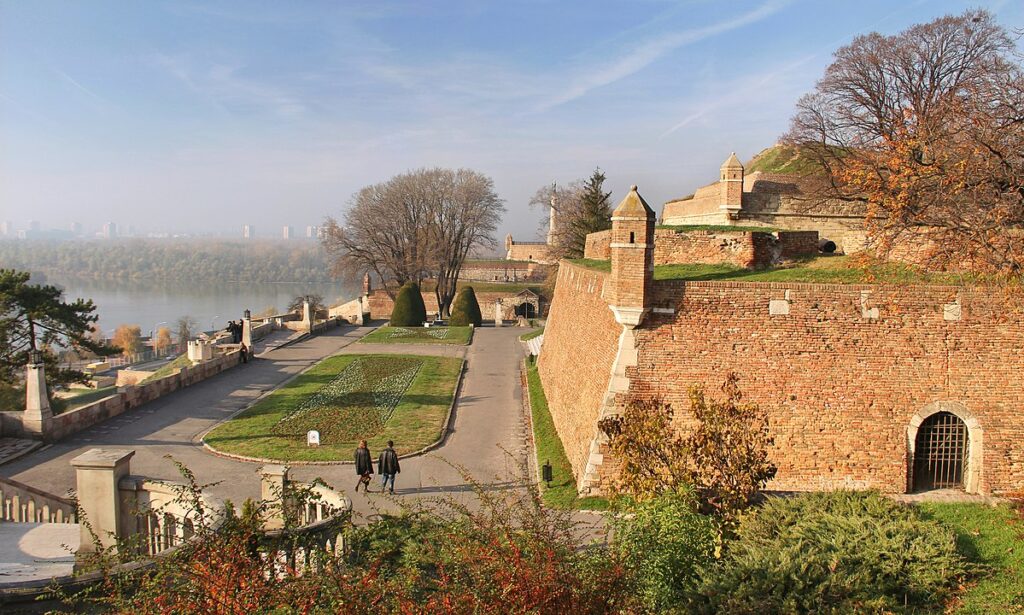
Kalemegdan Fortress history
The history of this significant complex is long and turbulent indeed. This impressive structure was built on a ridge above the confluence of two great rivers and has managed to remain preserved to this day, despite being demolished and rebuilt several times over the centuries. Kalemegdan has a history dating back a full 16 centuries and is the hallmark of our capital. According to the earliest findings, Kalemegdan Fortress was built between the 2nd and 18th centuries. It is a symbol not only of the city of Belgrade but also of something indestructible that bravely withstands time and destruction over the centuries. However, many times it was demolished, this fortress would always proudly rise again and regain its original splendor. The first fortification was built during the reign of the great and powerful Rome.
What to see at Kalemegdan Fortress?
The entire culture and identity of a nation are inseparably linked and intertwined with this spacious and magnificent fortress. Besides museums, galleries, and monuments, Kalemegdan Fortress is full of hidden places ideal for romantic walks. Below are some essential places and attractions you shouldn’t miss at Kalemegdan:
Kalemegdan’s Location
Kalemegdan Fortress is the most important attraction in the central part of Belgrade. It awaits you at the very end of Knez Mihailova Street, where just one pedestrian crossing separates the entrance to Kalemegdan Park and the building of the City Library. Trams 2, 10, and 11, as well as the city transport line EKO2, will take you to the fortress. Nearby is Studentski Park, which is also the terminus for Belgrade trolleys and buses 31. The good news for all drivers is the large number of public parking lots surrounding Kalemegdan.
Novi Sad proudly showcases the famous Petrovaradin and its beautiful fortress, which majestically rises from its foundations. As one of the leading economic, tourist, and cultural centers of the country, and especially of the picturesque Vojvodina region, Novi Sad is a city of extraordinary architecture, unique beauty, and a warm, welcoming atmosphere. It’s no wonder that many tourists are always eager to return.
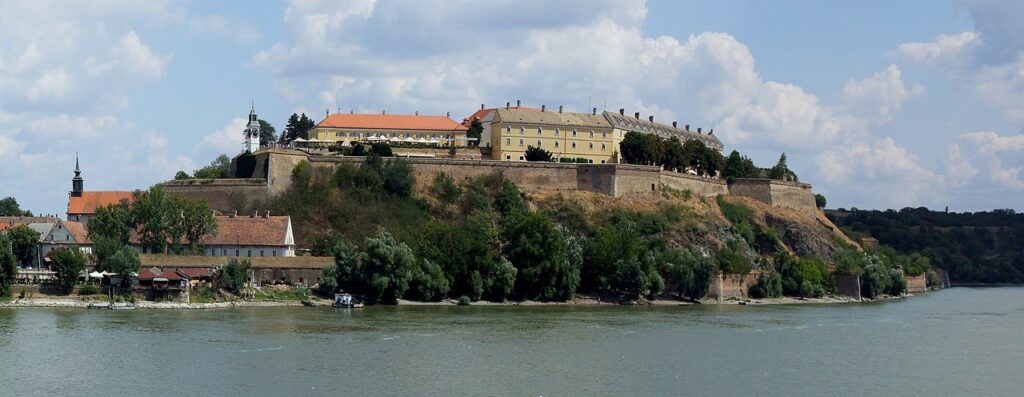
Аутор: Pudelek (Marcin Szala) – Сопствено дело, CC BY-SA 3.0 rs, https://commons.wikimedia.org/w/index.php?curid=21267188
Petrovaradin Fortress history
The history of Petrovaradin Fortress dates back to ancient times. The latest archaeological research indicates that Petrovaradin’s history spans more than 200 thousand years and leads us to the time when Celts inhabited these areas. During the Byzantine era, the fortress was called Petricon, and there are many testimonies from that time that speak of its beauty and grandeur. Petrovaradin Fortress is still one of the most beautiful and famous ancient buildings in all of Serbia.
The construction of the fortress lasted as long as 88 years, an entire lifetime, until 1867. Petrovaradin Fortress is of great importance to the city of Novi Sad and the entire surrounding area, so in the mid-20th century, it was declared a historical monument protected by the state. Today, it hosts the award-winning music festival Exit, which has put Serbia on the world music map.
Exploring Petrovaradin Fortress
Petrovaradin Fortress is always open and easily accessible to all tourists and Novi Sad residents. That’s why you can find numerous interesting attractions and educational content on it for many years. While walking through the fortress, be sure to stop by:
Where is the fortress located in Novi Sad?
Bus lines 9 and 9a take you directly to the fortress, which is connected to the city center and Danube Park by the Rainbow Bridge. You can also walk to the fortress; it takes less than 15 minutes from the city center and about 30 minutes from the bus and train stations. For drivers, it’s convenient to reach the Petrovaradin Fortress directly by car via the Belgrade Gate. There’s a large parking lot in front of the Museum, but it can get crowded, so you might have to wait for a spot to become available.
From the northern plains of Vojvodina, we move to the opposite end of Serbia, to the warmer, more temperate, and somewhat hilly regions of the south. The city of Niš is one of the three leading centers in the country and the capital of the entire southern region. In addition, Niš is now one of the foremost commercial and administrative centers, and its striking symbol is the unique and imposing Niš Fortress, which has successfully withstood the test of time and many upheavals for centuries. It is the symbol of Niš and one of its most beautiful sites that truly deserves your visit and time.
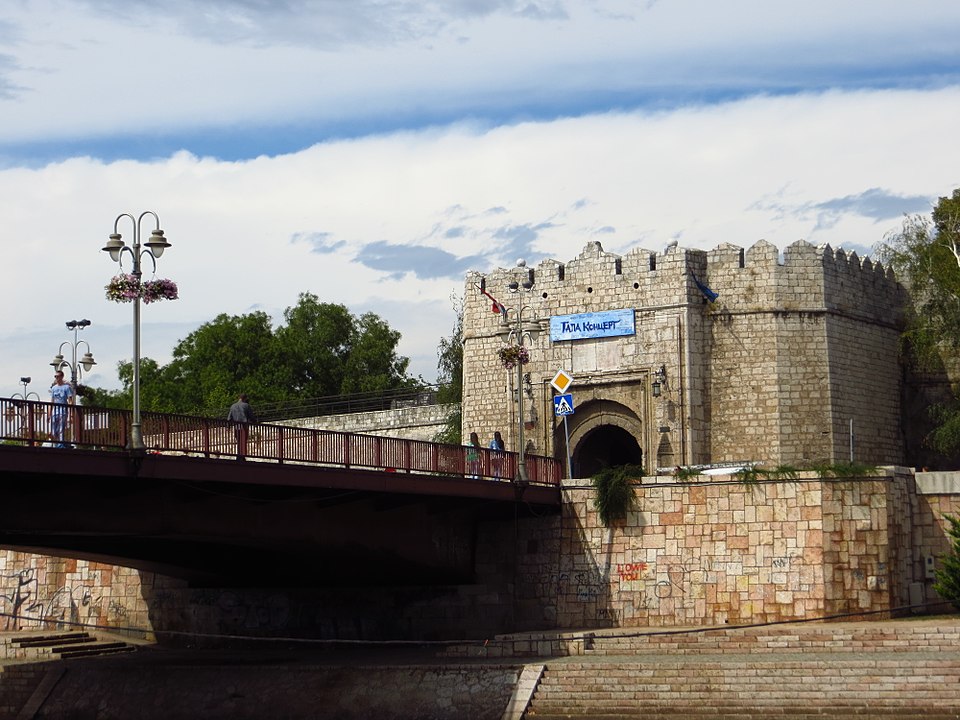
Аутор: Ivan Medenica – Сопствено дело, CC BY-SA 4.0, https://commons.wikimedia.org/w/index.php?curid=53578056
The Turbulent History of Niš Fortress
If you visit Niš, you can’t miss the Niš Fortress, located right in the city center and surrounded by strong, solid stone walls. This fortress boasts a long and turbulent history. The first records date back to when the Huns ruled and ruthlessly conquered the area. Unfortunately, the fortress suffered its first major destruction at their hands, only to be almost completely rebuilt by the famous Emperor Justinian. Its fortified walls and strategic position made it a desirable location, later conquered and used by the Turks for warfare and campaigns. Their influence is still evident in many parts of the Niš Fortress today.
Explore the Interior of Niš Fortress
Niš Fortress is indeed a special and important place in the city of Niš. Many locals and tourists visit this magnificent structure throughout the year. Besides enjoying the jazz sounds, pay attention to:
Location of Niš Fortress
All roads and cities in Serbia are well connected to Niš, making it easy to reach via the E75 route. The Niš Fortress is a prominent landmark in the city and is hard to miss. You can reach the fortress by walking along Mike Paligorić’s quay, which takes less than 15 minutes from the city center. Alternatively, you can take public transport on line 9.
On the right bank of the River Sava lies Shabac Fortress, the birthplace of the city of Shabac. Despite significant destruction, the fortress’s architecture remains intriguing. Throughout history, it has been known by various names, including Zaslon, Kula, Bugur tlen, and Bugur delen, reflecting its rich past. The earliest written records of Shabac Fortress date back to 1454, with its first fortification built during the Turkish arrival. Historically a strategic defense structure, Shabac Fortress is now a popular tourist attraction in this part of Serbia.
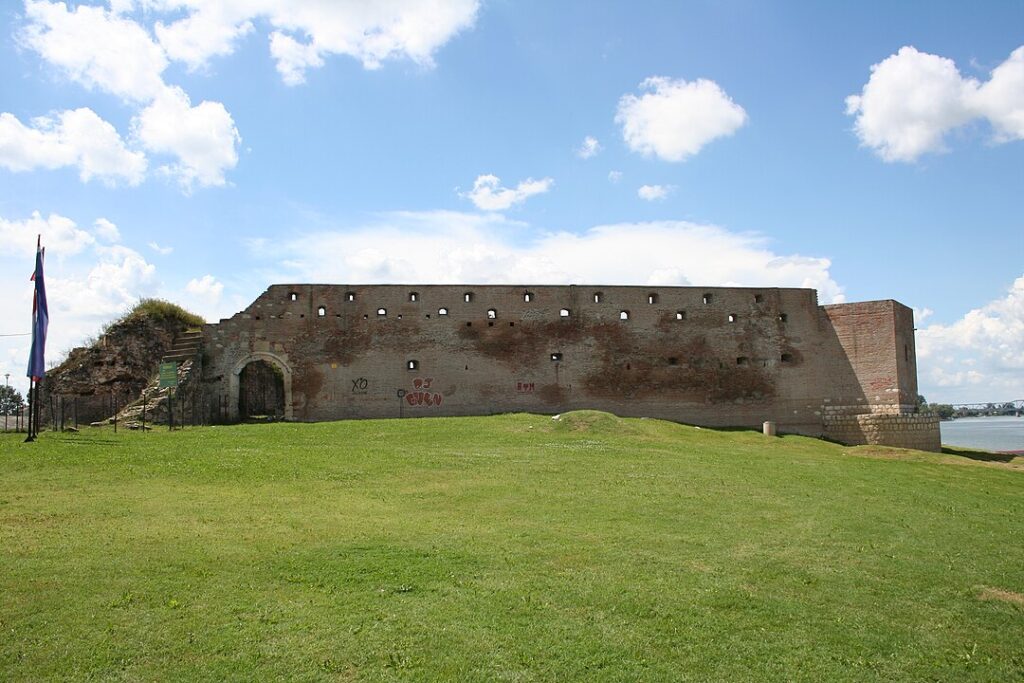
Аутор: Ванилица – Сопствено дело, CC BY-SA 4.0, https://commons.wikimedia.org/w/index.php?curid=49480303
Unique appearance of Shabac Fortress
Today, only the outlines of the quadrangular base with circular towers can be seen, which once proudly adorned this structure. You will notice this type of star-shaped fortification, which has a quadrilateral base, in most fortresses along the banks of the Sava River.
Our recommendation is to visit the remains of this former artillery fortification that has been bravely withstanding the winds coming from the river for centuries. A special attraction of this fortress in Shabac are the unique remains of earth and wooden ramparts, as well as a tower that proudly stood at the entrance and was entirely built of old bricks that can no longer be found. Today, this fortress is an ideal place for a walk throughout all seasons, a place where you can always enjoy its vastness and significance.
Location of Shabac Fortress
You can reach the city of Shabac via the new road and the E70 highway. Shabac is located 60 kilometers from Belgrade, 70 kilometers from Novi Sad, and 66 kilometers from Valjevo, with Niš being 320 kilometers away. From central Shabac, the streets Cara Dusan, Kralja Aleksandra, and Savska will guide you to the fortress, taking you through or past Tvrđavski Park to its ramparts.
If you want to travel through time, there’s no better place in Serbia than the stunning Golubac Fortress. This magnificent and well-preserved medieval structure is one of the most beautiful in Europe, captivating visitors with its towering spires and grand architecture.
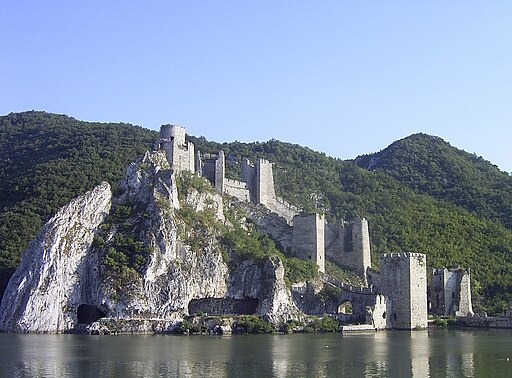
Denis Barthel, CC BY-SA 3.0 <http://creativecommons.org/licenses/by-sa/3.0/>, via Wikimedia Commons
We highly recommend also visiting the town of Golubac to enhance your experience. Located at the entrance to the picturesque Djerdap Gorge, the fortress is surrounded by equally impressive scenery. First mentioned in historical records in 1335, the exact builders of Golubac Fortress remain unknown. It served as a crucial administrative and military stronghold, with an appearance and interior befitting royalty.
Amazing walls of Golubac Fortress
The fortress is built to include the front, back, and lower town, with ten towers including one Donjon. Do not miss the opportunity to admire the beauty of their panoramas, gun openings, niches, and Orthodox chapel.
We warn you that the climb to the highest parts of the fortress is challenging, so you will need professional guidance to reach them. In addition, our advice to all tourists is to visit the permanent exhibition of the fortress called Panorama of Centuries, which will present you with an authentic and picturesque representation of all the important events that took place during the long history of Golubac Fortress. In the immediate vicinity of the fortress, there is also a prominent archaeological park where medieval artifacts found in the fortress and its territory are displayed.
Every visitor at the entrance of the fortress can buy four types of daily tickets, depending on how long they want to stay in the fortress and what they want to visit.
Zone 1 – Green zone offers access to the palace and towers 8, 5, and 9 for 750 dinars.
Zone 2 – Blue zone includes access and towers 3 and 4 and costs 1200 dinars.
Zone 3 – Red zone includes an additional visit to tower 7 and will cost you 1200 dinars.
Zone 4 – Black zone includes a visit to the Hat tower, and access is only allowed to adults accompanied by a guide; the price is 1,700 dinars.
Where is Golubac Fortress located?
Golubac is situated on the Belgrade-Kladovo highway, 130 km from Belgrade, 220 km from Novi Sad, and 243 km from Niš. The quickest route to the fortress is via state road 34, which links Djerdap and eastern Serbia with the Pomoravlje region and the Belgrade area. This road passes through several notable places, including Požarevac, Bratinac, Beranje, Veliko Gradište, Braničevo, Porečki Bridge, and Donji Milanovac.
If you were to ask people what Pirot is most famous for, most would mention Kale Fortress. Known as Momcilo’s City, Pirot’s ancient fortress features towers and walls divided into three main sections. Kale Fortress has witnessed countless wars and upheavals over the centuries, with significant influences from Antiquity, Byzantium, and the Middle Ages leaving their mark. According to legend, the fortress is linked to the renowned voivode Momcilo, celebrated in Serbian folk literature. Additionally, part of the movie “Battle of Kosovo” was filmed at this picturesque location.
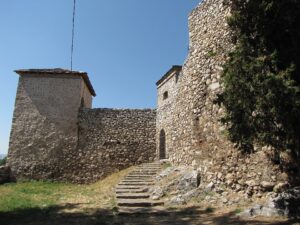
Аутор: Ivan Medenica – Сопствено дело, CC BY-SA 4.0, https://commons.wikimedia.org/w/index.php?curid=53578056
History and significance of Kale Fortress
The exact age of this fortress remains uncertain, but archaeologists have made significant discoveries dating back to the Middle Ages. It is believed that the fortress existed during the Roman Empire and served as an important center at that time. The Turks also recognized the significance of the fortress in Pirot, but they did not conquer it until the 15th century. Duke Dimitrije successfully reclaimed it in 1836. According to folk tradition, the fortress and its construction are associated with Momcilo, a fearless hero celebrated in Serbian epic poems for his constant battles against Turkish sieges. Over time, the fortress has become an attraction due to its cinematic scenes, impressive beauty, and the ancient legends that continue to be told about it.
Where is Kale Fortress located in Pirot?
The distance between Pirot and Belgrade is 304 km, and the fastest way to reach this city is via the E75 highway, after which you should exit to the A44 road. If you are heading towards the fortress from Pirot, you can follow the streets Srpskih Vladara, Knjaza Milosa, Vojvode Misica, Slavonska, and Nikola Tesla. The fortress is located near the bus station, and you will not have a problem finding parking.
Of course, no discussion would be complete without mentioning the renowned and historically significant Smederevo Fortress, which played a crucial role in the Serbian medieval despotate. Built by the notable despot Đurađ Branković, this fortress served as a military, cultural, and ecclesiastical center. Today, it stands as one of the best-preserved fortresses, enduring the test of time.
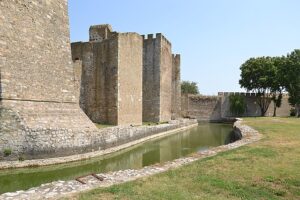
Аутор: Pudelek (Marcin Szala) – Сопствено дело, CC BY-SA 3.0 rs, https://commons.wikimedia.org/w/index.php?curid=28203627
Strategically located at the confluence of the Jezava River and the Danube, the fortress spans an impressive 11 hectares. It consists of two equally important sections: the Great Town and the Small Town. The architecture and precision of this magnificent structure continue to fascinate both architects and tourists alike.
Interesting Facts About Smederevo Fortress
Smederevo Fortress was erected to defend against the Turks, making it an attraction truly worth visiting. What has always intrigued many visitors are the legends about the fortress and the conditions under which it was built. Here are some particularly interesting facts about the fortress:
How to Reach Smederevo Fortress?
Smederevo is situated on the banks of the Danube in the northeastern part of Šumadija, just 46 kilometers from Belgrade, with the European route E-75 Belgrade – Niš nearby. The Smederevo Fortress is conveniently located directly across from the bus and train stations, making it easy to find. To reach the fortress, follow Despota Đurđa, Đure Salaja, and Save Nemanjića streets. While in this part of the city, be sure to also visit the nearby Smederevo City Museum and the June 5th Monument.
If you love stories and are fascinated by Camelot, you’ll be delighted to discover that Serbia boasts its own ancient fortress, Maglič, which looks like it belongs in a fairy tale or fantasy world. Nestled among the green hills and meadows of central Serbia, near the town of Kraljevo, Maglič once served as the residence of Serbian Archbishop Danilo II, who managed both ecclesiastical and state affairs from this fortress. Declared a Monument of Culture of Exceptional Importance in 1979, Maglič is now one of the most popular historical landmarks in Serbia, frequently appearing on various must-visit lists.
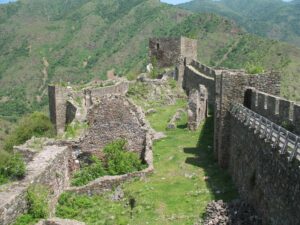
Јавно власништво, https://commons.wikimedia.org/w/index.php?curid=582391
Legends of Maglič
Many mysteries surround this medieval castle, which was built in the heart of the Ibar Gorge and is surrounded on three sides by the Ibar River. To this day, it is not precisely known who built this fortress, but many stories mention Uroš I, who is believed to have constructed it to prevent further Mongol incursions through the gorge. Other legends claim that the fortress was built by Stefan the First-Crowned to protect his endowments.
One thing is certain: it dates back to the 13th century and overlooks the surroundings from the top of a hill. Another significant period in the history of Maglič is the Second Serbian Uprising, where an ambush was set for the Turks near Maglič.
Experience Maglič from the Ibar River
The “Merry Descent” is the most popular activity in this area, constantly attracting many visitors. It involves rafting on the Ibar River, which surrounds the fortress. This is a unique opportunity for all interested to learn about the rich history and tradition of Maglič Fortress, as well as the stunning, still untouched, and lush nature surrounding the fortress. The Ibar Valley is one of the hidden natural gems of central Serbia and one of the most beautiful offerings of the region’s nature, with a visit to Maglič Fortress further enhancing the entire experience. Viewed from the heights, Maglič seems unattainable, and architecture enthusiasts will particularly enjoy this activity. Don’t forget to bring a life jacket, food, and good spirits, as you can expect 12 hours of fun on the water!
Location of Maglič
Situated just 20 km south of Kraljevo, this medieval castle perches atop a steep hill, standing 100 meters above the gorge floor. The route to Maglič is clearly marked with signs and is well-lit at night, ensuring a hassle-free journey. The closest point to Maglič reachable by car from Kraljevo’s center is a mere 25 km, requiring only about half an hour of driving time. Follow the E-761 highway, tracing the path of the Ibar River, passing through Čibukovac, Konarevo, Progorelica, and Zamčenje. To access the fortress entrance, continue along state road 22, and until a bridge is constructed, a boat is necessary to cross the Ibar River.
Bortanj was originally situated within the former Kingdom of Hungary, and today, it spans areas near the city of Sombor. The fortress, constructed in this vicinity, came into being during the early stages of the settlement that would evolve into modern-day Sombor. This medieval stronghold, renowned for its beauty, stands as one of Vojvodina’s most exquisite and sought-after attractions.
Once serving as a military stronghold for influential Hungarian rulers, the fortress was recognized as a Monument of Culture of Great Importance in 1948. Today, visitors can explore its remains and marvel at the splendor of medieval architecture.
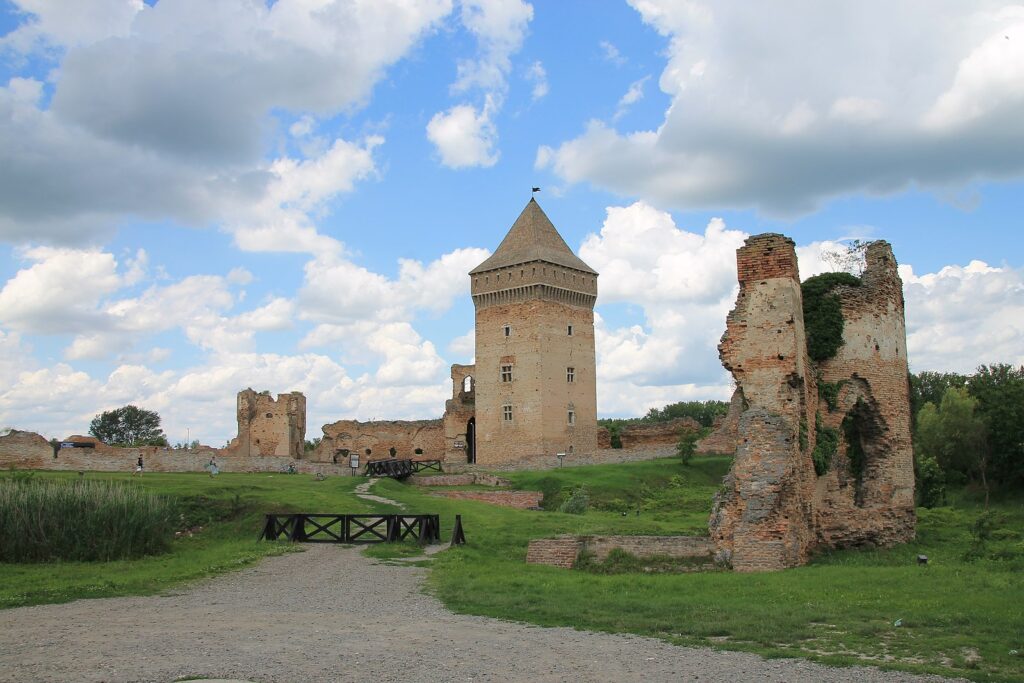
Ванилица, CC BY-SA 4.0 <https://creativecommons.org/licenses/by-sa/4.0>, via Wikimedia Commons
History and Significance of Bač Fortress
Historical records suggest that construction of the fortress occurred between 1338 and 1342 under the reign of Hungarian King Charles Robert. Consequently, traces of Hungarian architectural style and embellishments are still discernible in the remnants of this medieval stronghold.
Serving as a pivotal hub for administration, commerce, culture, ecclesiastical affairs, and politics, the fortress held immense significance in its heyday.
Despite enduring substantial damage during the Rákóczi uprising, it retained its status as the most well-preserved fortress in Vojvodina. The initial archaeological excavations occurred in the early 20th century, unearthing a trove of medieval artifacts, documents, and ceramic fragments scattered across the fortress grounds.
Presently, the fortress itself stands as a captivating spectacle, featuring a grand tower prominently positioned within the fortification’s central area. Alongside, a multitude of archaeological discoveries adds to its allure, attracting a steady stream of visitors. Within these walls lies a treasure trove of Serbian cultural heritage and medieval customs. Interestingly, this stronghold was once dubbed the “Water City” due to its encirclement by water, rendering it formidable to assail. Over the centuries, the fortress has hosted a diverse array of peoples, from Celts and Slavs to Hungarians. Now, it’s your turn to tread the same paths as those before you. Ascend to the summit of the central tower, offering a singular vantage point unparalleled in Vojvodina.
How to Get to Bač Fortress?
The best way to reach Bač Fortress is via Sombor or Bačka Palanka, which is only 22 km away. You have regular bus lines to Bač, especially from Novi Sad. If you prefer to drive, follow the state road 12 from Sombor to the fortress. In that case, prepare for a journey of 55 km through the towns of Stapar, Srpski Miletići, Odžaci, Deronje, and Bač, and set aside about an hour for the trip. Near Bač Fortress is also the Information Center of the Bač Tourist Organization, where you can get additional information.
This ancient town served as a pivotal administrative and military stronghold in medieval Raška. Formerly a bustling economic and trading center, it now stands as a collection of remnants and ruins, eloquently recounting its once-significant role in history. Designated as a Monument of Culture of Exceptional Importance, the old town of Ras preserves the legacy of the Raška state. Visitors have the opportunity to delve into the rich tapestry of Serbian history and tradition, amidst the backdrop of pristine nature and awe-inspiring landscapes.
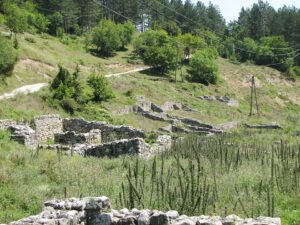
Аутор: Wlodzimierz – Сопствено дело, CC BY-SA 4.0, https://commons.wikimedia.org/w/index.php?curid=35150342
What is the significance of the Ras Fortress?
The long and rich history of this town is evidenced by the excavations on the site that date back to the Bronze Age. The rise and prosperity of Raška began after the fall of the Bulgarian Empire when this fortress once again became part of the great Byzantine power. After 1427, the town came into the possession of Despot Đurađ Branković, only to fall under Turkish rule following the first fall of the despotate. This town once saw the making of the most important political and strategic decisions of the Serbian state of that time.
Explore the Ruins of the Ras Fortress
This ancient site attracts a significant influx of tourists from both the country and the surrounding region on a regular basis. Among its main draws is the distinctive shape of the fortification, perched atop a mountain ridge. The fortress takes on an irregular quadrilateral form, sprawling across nearly 20 hectares of land, featuring five towers interconnected by robust walls. Additionally, visitors can explore the impressive remnants of a former castle, accessible via the main gate. Situated at the intersection of crucial western and southern routes, the old town’s location bestowed it with exceptional strategic significance.
Location of the Ras Fortress
This significant medieval complex is located 11 km from Novi Pazar, near the Sopoćani Monastery. Nearby are the towns of Požega and Ivanča, and we suggest you reach Ras by car from the direction of Raška. The distance between Raška and the fortress is about 35 km, less than an hour’s drive. Follow the E-761 highway through the settlements of Draganići, Nosoljin, and Panojevići, and near Novi Pazar, switch to the state road 29. Near Ivanča, take road 203, which leads to the fortress, following the course of the Raška and Sebečevska rivers.

Leave Your Comment